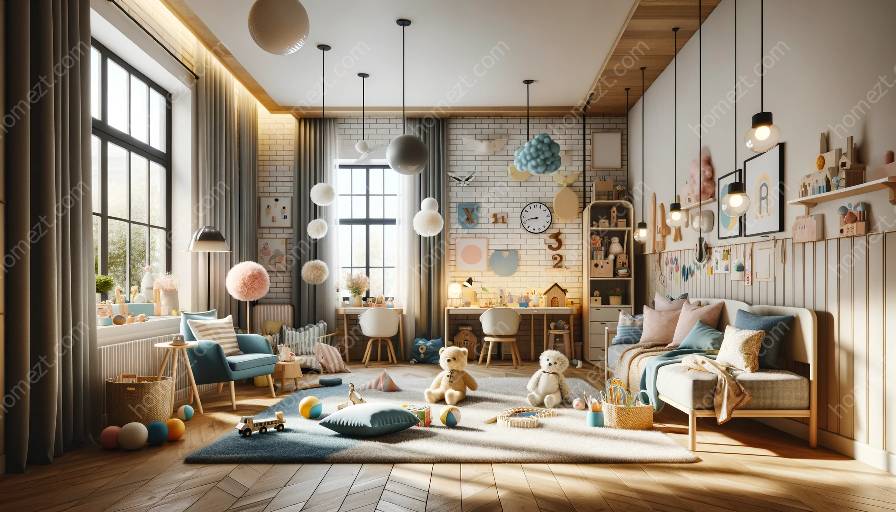Children's rooms are essential spaces for nurturing creativity and play. Finding the balance between functional design and creative stimulation is crucial in creating a space that allows children to express themselves, explore, and learn. In this topic cluster, we will explore the intersection of children's room design and interior design, focusing on innovative ways to promote creativity and play in children's rooms through attractive and practical design concepts.
Understanding the Importance of Creativity and Play
Before delving into the design aspects, it's important to emphasize the significance of promoting creativity and play in children's rooms. Creativity is a fundamental skill that helps children develop problem-solving abilities, think critically, and express themselves freely. Play, on the other hand, fosters cognitive, social, and emotional development. By creating an environment that encourages both creativity and play, children can enhance their skills and overall well-being.
Designing for Creativity and Play
When thinking about promoting creativity and play in children's rooms, several design elements come into play. Color, layout, furniture, and storage solutions all contribute to the overall atmosphere and functionality of the room.
Color and Visual Stimulation
Color has a profound impact on a child's mood and behavior. Bright, vibrant colors can energize and inspire creativity, while softer pastel hues promote a calm and peaceful environment for play and relaxation. Incorporating interactive and visually stimulating elements, such as wall decals, murals, and interactive art, can further enhance the creative atmosphere of the room.
Flexible Layout and Multi-functional Furniture
Adopting a flexible layout that allows for multifunctional spaces encourages creativity and play. Modular furniture, such as convertible beds, desks, and play tables, provides versatility and adaptability to accommodate various activities and creative endeavors. Additionally, incorporating dedicated areas for different activities, such as reading nooks, craft corners, and play zones, ensures that children have designated spaces for different forms of play and creativity.
Storage Solutions and Organization
An organized and clutter-free environment is essential for promoting creativity and play. Utilizing creative storage solutions, such as wall-mounted shelves, under-bed compartments, and playful storage bins, helps maintain tidiness and accessibility of toys, art supplies, and educational materials. This not only promotes a sense of responsibility and organization in children but also creates a conducive environment for imaginative play and creativity.
Integrating Playful Themes and Interactive Elements
Thematic elements and interactive features can greatly contribute to the promotion of creativity and play in children's rooms. Incorporating playful themes that align with a child's interests and hobbies, such as nature, outer space, or fantasy worlds, can stimulate imagination and creativity. Interactive elements, such as chalkboard walls, sensory play areas, and interactive learning stations, provide opportunities for hands-on exploration and discovery.
Bringing Nature Indoors
Connecting children with nature within their room environment can foster creativity and a sense of wonder. Integrating natural elements, such as potted plants, nature-inspired artwork, and organic textiles, creates a calming and nurturing atmosphere, allowing children to explore and appreciate the natural world. Additionally, natural light and views of the outdoors can enhance the sensory experience and creativity of children in their rooms.
Developing Personalized Creative Zones
Recognizing the unique interests and talents of each child is essential in promoting creativity and play. Creating personalized creative zones tailored to a child's hobbies, such as music, art, or science, empowers them to pursue and develop their passions. Whether it's a music corner with musical instruments, an art station equipped with various art supplies, or a science laboratory for experimenting, these dedicated zones encourage self-expression, skill development, and imaginative play.
Interactive Spaces for Collaborative Play
Designing spaces that facilitate collaborative play adds an additional dimension to promoting creativity. Areas for group activities, such as board games, building blocks, and pretend play, encourage social interaction, teamwork, and creative problem-solving. Creating environments that allow for imaginative group play fosters positive social development and cooperative creativity.
Encouraging Expression and Personalization
Providing opportunities for children to express themselves and personalize their space is integral to nurturing their creativity. Displaying children's artwork, creating a dedicated gallery wall, or incorporating customizable elements, such as chalkboard surfaces or pegboards, enables children to leave their mark on their environment, fostering a sense of ownership and inspiration.
Harmonizing Design and Functionality
Ultimately, promoting creativity and play in children's rooms is about harmonizing design and functionality. It's essential to strike a balance between creating an aesthetically pleasing and inspiring space while ensuring that it remains practical and functional for everyday use. Integrating innovative design solutions, imaginative play areas, and organizational features enables children to thrive creatively while maintaining a well-structured and inviting room environment.
Incorporating Digital and Technological Creativity
In the modern age, integrating digital and technological elements into children's room design can further promote creativity. Incorporating interactive digital art displays, educational gaming stations, or programmable gadgets can inspire children to explore the creative possibilities of technology while fostering critical thinking and problem-solving skills.
Conclusion
Promoting creativity and play in children's rooms is an artful blend of practicality, innovation, and inspiration. By incorporating thoughtful design elements and embracing the intersection of children's room design and interior design, a space that encourages creativity, exploration, and play can be created. With a harmonious balance of color, layout, furniture, thematic elements, and personalization, children's rooms can become vibrant, imaginative spaces that nurture the young minds of tomorrow.


























